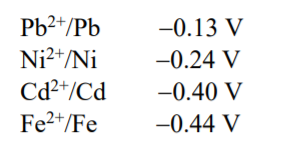Faraday constant __________.
is a numerical constant
depends on equivalent
depends upon the current passed
depends on the number of electrons
The correct Answer is:A
Step by step video, text & image solution for Faraday constant __________. by Chemistry experts to help you in doubts & scoring excellent marks in Class 12 exams.
Topper's Solved these Questions
- BOOK - TARGET PUBLICATIONCHAPTER - ELECTROCHEMISTRYEXERCISE - COMPETITIVE THINKING103videos
ELECTROCHEMISTRY
- BOOK - TARGET PUBLICATIONCHAPTER - ELECTROCHEMISTRYEXERCISE - EVALUATION TEST19videos
ELECTROCHEMISTRY
- BOOK - TARGET PUBLICATIONCHAPTER - ELECTROCHEMISTRYEXERCISE - EVALUATION TEST19videos
ELECTROCHEMISTRY
- BOOK - TARGET PUBLICATIONCHAPTER - D AND F-BLOCK ELEMENT EXERCISE - EVALUATION TEST15videos
D AND F-BLOCK ELEMENT
- BOOK - TARGET PUBLICATIONCHAPTER - GENERAL PRINCIPLES AND PROCESSES OF ISOLATION OF ELEMENTSEXERCISE - Evaluation Thinking15videos
GENERAL PRINCIPLES AND PROCESSES OF ISOLATION OF ELEMENTS
Similar Questions
It is desired to deposit 0.254 kg of copper on the cathode of a copper voltameter . How long will it take to deposit this amount if a steady current of 100 A is maintained . Use the known value of Faraday constant . Relative atomic mass of copper is 63.5 .
View SolutionA steady current of 10.0 A is passed through a water voltameter for 300 s . Estimate the volume of H2 evolved at standard temperature and pressure . Use the known value of Faraday constant . Relative molecular mass of H2 is 2.016 and molar volume = 22.4 litres (volume of 1 mol of an ideal gas at STP).
View Solution
Knowledge Check
- Question 1 - Select One
Numerical value of Faraday's constant is :
A96500 CB96800 CC95600 CD96400 C - Question 2 - Select One
Faraday's constant is defined as
Acharge carried by 1 electronBcharge carried by one mole of electronsCcharge required to deposit one mole of substanceDcharge carried by two moles of electrons. - Question 3 - Select One
Electrolysis is the process in which electrical energy is converted to chemical energy. In electrolytic cell, oxidation takes place at anode and reduction at cathode. Electrode process depends on the electrode taken for electrolysis. Amount of substance liberated at an electrode is directly propertional to the amount of charge passed through it. The mass of substance liberated at electrode is calculated using the following relation :
m=ItE96500
Here, E represents the equivalent mass and 96500 C is called the Faraday constant. Faraday (96500 C) is the charge of 1 mole electron, i.e., 6.023×1023 electrons, it is used to liberate one gram equivalent of the substance.
How many faradays are required to reduce 1 mol BrO−3 to Br− ?A3B5C6D4
Faraday's law
View SolutionA current of 1A is possed through a dilute solution of sulphuric acid for some time to liberate 1g of oxygen. How much hydrogen is liberated during this period? How long was the current passed? Faraday constant =96500Cmol−1.
View SolutionA current of 1 A is passed through a dilute solution of sulphuric acid for some time to liberate 1 g of oxygen. How much hydrogen is liberated during this period ? How long the current was passed ? Faraday constant =96500mol−1
View SolutionSome standard electrode potentials at 298K are given below:

To a solution containing 0.001M of X2+ and 0.1M of Y2+, the metal rods X and Y are inserted (at298K) and connected by a conducting wire. This resulted in dissolution of X. The correct combinations of X and Y, respectively is (are)
(Given: Gas constant, R=8.314JK−1mol−1, Faraday constant,F= 96500Cmol−1)View SolutionSuppose that gold is being plated on to another metal in an electrolytic cell. The half - cell reaction producing the Au(s) is AuCl−4+3e−+Au(s)+4Cl−. If a 0.30 A current runs for 15.00 minute, what mass of Au(s) will be plated, assume all the electrons are used in the reduction of AuCl−4 ? the Faraday constant is 96485 C/mol and molar mass of Au is 197.
View Solution

